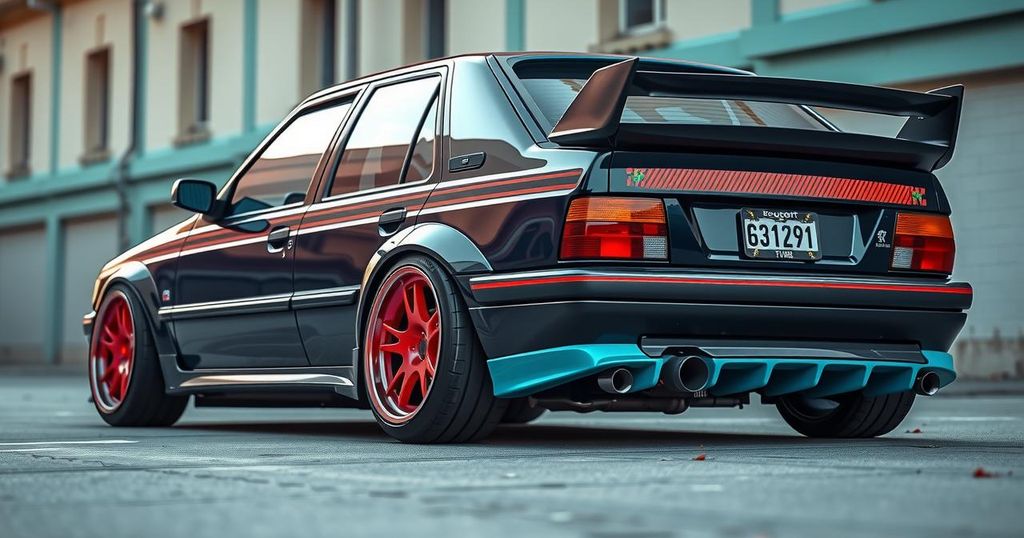Exploring Iran’s Unconventional Tuner Culture: The Peugeot 405 Phenomenon

The Peugeot 405, a long-standing favorite in Iran’s automotive landscape, epitomizes local tuner culture with its distinct modifications. More than three decades in production, this cherished vehicle represents a unique community among Iranians, with trends such as elevated rear ends reflecting practical origins tied to smuggling and evolving into stylistic expressions. As enthusiasts continue to modify and enhance their cars, a vibrant passion for the 405 thrives, even if it’s largely unseen by the global automotive community.
In Iran, a unique tuner culture has emerged centered around the Peugeot 405. This beloved sedan has been in production in the country for more than three decades, having established its roots in Iran back in 1992 following its original debut in France in 1987. The car is still produced today as the Peugeot PARS by the local automaker Iran Khodro, but, last year marked the end of its run due to increased competition from modern vehicles, particularly those from China.
With countless Peugeot 405s populating Iranian streets, they have become a significant part of car culture within the region. This past week, a local named Shayan reached out, having spotted previous coverage on the subject. He shared insights on how much Iranians appreciate the Peugeot 405. “Even though it has been 37 years since this car entered Iran, all young and middle-aged people are interested in this car,” he stated, further revealing the widespread admiration for the different trims, especially the GLX.
The GLX variant of the Peugeot 405 is exceptionally sought after. “It’s a very beautiful version… produced in Iran with the XU9 and XU7 L3 engines,” Shayan explained. These models are favored for modifications. The engrained tradition of tinkering with the car to enhance its performance plays a vital role in Iran’s tuner scene. For the uninitiated, the XU7 L3 engine is a modest 1.8-liter inline-four producing around 100 horsepower. Enthusiasts make the most of what they have, opting for modifications that can include everything from intake upgrades to more significant changes involving turbos.
Among these tuners, there is also the later Pars ELX, which features a 1.9-liter engine that doles out 105 horsepower. It has quickly gained popularity in the modification community, with frequent engine swaps reported throughout social media. Stock Peugeots can touch speeds of 118 mph, however, some delight in pushing these limits, with Shayan enthusiastically recalling instances of reaching 160 mph.
Speed runs are a popular activity within the Iranian Peugeot fanbase. Social media houses a trove of videos showcasing these vehicles as they achieve remarkable feats. Many cars remain deceptively standard in appearance but host an array of upgrades under the hood. But what stands out as intriguingly unique in Iran is the phenomenon of modified 405s elevated in the rear.
Shayan offered insights into why this trend exists. Traditionally, in the West and Japan, cars are lowered to enhance the sporty aesthetic, yet Iran takes a different approach. The elevation of the rear is rooted in practicality: smugglers initiated the trend to keep the car moving swiftly without the rear scraping the ground when loaded. As this look became popularized, it adapted into a visual style among car enthusiasts.
Impressively, some modders cleverly utilize air suspension, allowing the car’s height to be dynamically adjusted—jacked up for show and lowered for everyday use. Unique owner innovations also abound; one even devised a means to dispense caltrops from their 405 as a deterrent for pursuers. Moreover, Iranians tend to refer to their tuned vehicles as “fighter jets,” indicative of their de facto pride in the Peugeot 405.
Shayan himself owns a modified 405 GLX; it retains that somewhat stock look aside from its elevated stance and enhanced engine performance. The depth of Iran’s tuner culture is not extensively covered in the worldwide car scene and is mostly veiled from broader views, making contributions from locals like Shayan invaluable for understanding this distinct world.
It is noteworthy that the Peugeot 405 holds a significant space in Iranian automotive culture. The vehicle has sold in the hundreds of thousands over the years, creating a substantial enthusiast community. Despite political realities limiting cultural exchanges, it becomes evident that the passion for cars knows no borders; Iranians have embraced their Peugeot 405s just as car lovers do elsewhere, modifying, enhancing, and enjoying the experience, no matter the challenges.
The Peugeot 405 has carved out a significant niche in Iranian tuner culture, demonstrating a unique form of automotive appreciation that’s relatively unexplored by the wider world. Although overshadowed by prevalent political and cultural barriers, these enthusiasts showcase a shared passion for modifying and improving their vehicles. The blend of practicality and aesthetics, particularly the notable rear lift trend, significantly distinguishes their approach to tuning, revealing a rich car culture thriving beneath the surface in Iran. This phenomenon emphasizes that car enthusiasm transcends geographical boundaries, fostering a relatable connection among all car lovers, regardless of locale.
Original Source: www.theautopian.com






